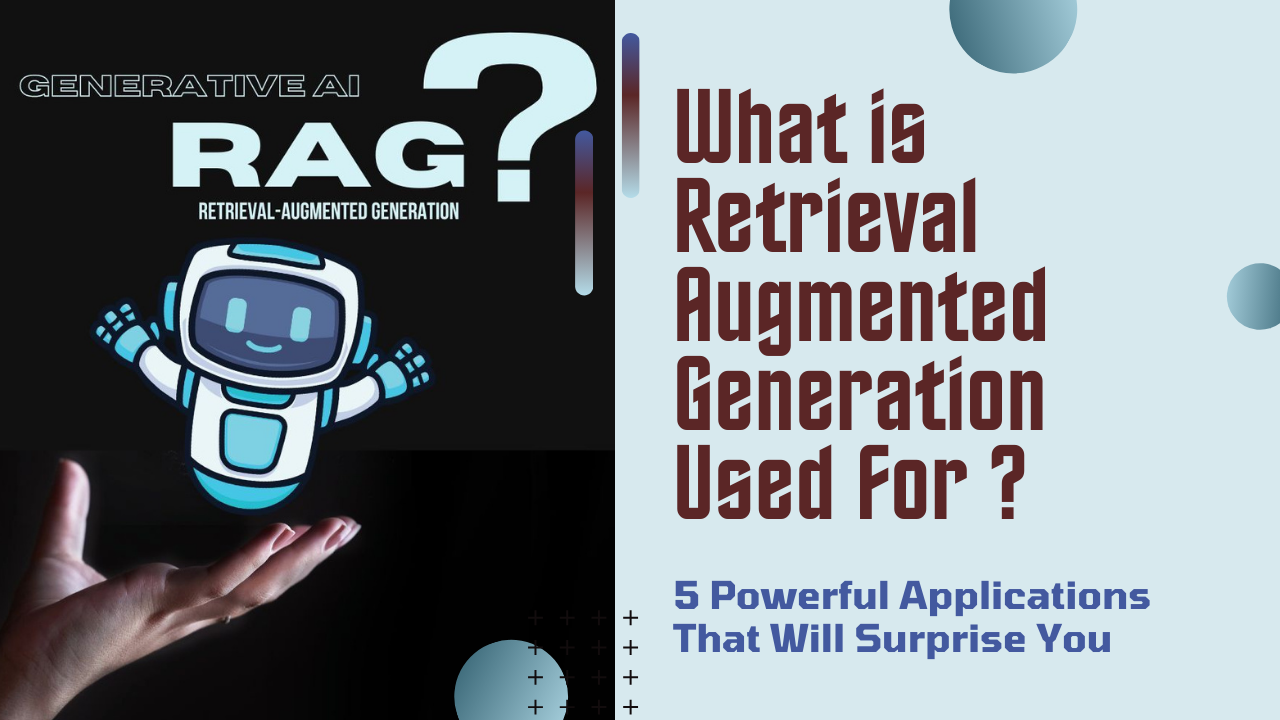Get Fluid GPT for your organization and transform the way you work forever!
Talk to our GPT Specialist!


Have you ever wondered how chatbots and virtual assistants are getting smarter? It's thanks to amazing new tools in the world of AI! One exciting technique called Retrieval Augmented Generation (RAG) is helping AI assistants and other cool tech to become more accurate and helpful in their responses. Think of RAG as a super-powered memory for AI, allowing it to not only come up with creative ideas but also check facts and find relevant information to give you the best possible answer! Keep reading to learn more about the surprising ways RAG is being used!However, what is retrieving augmented generation completely, and how is it applied? This blog delves deeply into the realm of RAG, examining its essential features and presenting five potent applications that will astound you.
A Broad Overview of Retrieval Augmented Generation (RAG)
Imagine you are conversing with an extremely knowledgeable friend. In addition to coming up with original ideas, this friend's extensive knowledge base allows them to easily include pertinent facts to ensure thoughtful and correct responses. That's exactly what artificial intelligence's Retrieval Augmented Generation tries to achieve.
Retrieval: This stage involves searching through a massive dataset of text and code to find the most relevant information related to the prompt or query. Think of it as your friend scanning their memory for past experiences and knowledge.
Augmentation: Once relevant information is retrieved, RAG doesn't simply regurgitate it. It analyzes and processes this information, drawing connections and identifying patterns. This "augmentation" allows the AI to understand the context and intent behind the query, similar to how your friend interprets the situation based on past knowledge.
Generation: Finally, using the retrieved and augmented information, RAG generates a response that is not only creative and relevant but also factually accurate and contextually appropriate. Imagine your friend using their understanding to craft a well-informed and insightful answer to your question.
Traditionally, AI text generation models relied solely on their internal training data. This often led to factually inaccurate responses, lacked context, or simply didn't make sense. RAG bridges this gap by incorporating external knowledge retrieval, resulting in several key advantages:
Improved Accuracy: By verifying information with external sources, RAG ensures the generated text is factually sound and reliable.
Enhanced Context: Through analysis of retrieved information, RAG understands the context of the query, leading to more relevant and meaningful responses.
Greater Creativity: With access to a wider range of information, RAG can generate more creative and diverse content.
Reduced Bias: By relying on factual data retrieval, RAG helps mitigate potential bias present within the training data of AI models.
Now that we understand the core principles of RAG, let's explore some surprising and impactful applications across various industries.
Imagine a chatbot that can provide accurate and insightful information in addition to providing polite responses to your questions based on past interactions and real-time data. RAG can give chatbots the ability to efficiently process complicated requests, enhancing customer support interactions.
For instance, a customer support chatbot that was enabled by RAG may identify a customer's annoyance with a product, collect pertinent troubleshooting instructions from a knowledge base, and provide real-time remedy suggestions.

The world of content creation is constantly buzzing with activity. RAG can be a game-changer for writers, content marketers, and even social media managers. Imagine an AI that can not only generate creative ideas for blog posts and social media captions but also ensure factual accuracy and draw upon relevant data and statistics. RAG can automate repetitive tasks and fact-checking while allowing human creativity to shine through.

The content on search engine results pages (SERPs) is frequently superfluous. By evaluating user queries and extracting the most pertinent facts from large databases, RAG can enhance search results. Imagine searching for a specific medical condition and receiving not only general information but also links to scholarly articles and reliable patient support groups.

The scientific research process involves sifting through mountains of data and literature. RAG can be a valuable tool for researchers, helping them quickly identify relevant studies, analyze data points, and even generate hypotheses based on retrieved information. This can significantly accelerate scientific discovery and development.

E-commerce sites and marketing teams can employ RAG to enhance ads and personalize customer experiences. Imagine a recommendation engine that not only suggests things based on your prior purchases but also provides you with relevant user reviews and product comparisons to assist you make decisions.
These represent just a small sample of the many uses for Retrieval Augmented Generation. We could expect even more noteworthy and unexpected applications in a range of industries as technology advances.

| Decision points | Open-Source LLM | Close-Source LLM |
|---|---|---|
| Accessibility | The code behind the LLM is freely available for anyone to inspect, modify, and use. This fosters collaboration and innovation. | The underlying code is proprietary and not accessible to the public. Users rely on the terms and conditions set by the developer. |
| Customization | LLMs can be customized and adapted for specific tasks or applications. Developers can fine-tune the models and experiment with new techniques. | Customization options are typically limited. Users might have some options to adjust parameters, but are restricted to the functionalities provided by the developer. |
| Community & Development | Benefit from a thriving community of developers and researchers who contribute to improvements, bug fixes, and feature enhancements. | Development is controlled by the owning company, with limited external contributions. |
| Support | Support may come from the community, but users may need to rely on in-house expertise for troubleshooting and maintenance. | Typically comes with dedicated support from the developer, offering professional assistance and guidance. |
| Cost | Generally free to use, with minimal costs for running the model on your own infrastructure, & may require investment in technical expertise for customization and maintenance. | May involve licensing fees, pay-per-use models or require cloud-based access with associated costs. |
| Transparency & Bias | Greater transparency as the training data and methods are open to scrutiny, potentially reducing bias. | Limited transparency makes it harder to identify and address potential biases within the model. |
| IP | Code and potentially training data are publicly accessible, can be used as a foundation for building new models. | Code and training data are considered trade secrets, no external contributions |
| Security | Training data might be accessible, raising privacy concerns if it contains sensitive information & Security relies on the community | The codebase is not publicly accessible, control over the training data and stricter privacy measures & Security depends on the vendor's commitment |
| Scalability | Users might need to invest in their own infrastructure to train and run very large models & require leveraging community experts resources | Companies often have access to significant resources for training and scaling their models and can be offered as cloud-based services |
| Deployment & Integration Complexity | Offers greater flexibility for customization and integration into specific workflows but often requires more technical knowledge | Typically designed for ease of deployment and integration with minimal technical setup. Customization options might be limited to functionalities offered by the vendor. |
What is Retrieval Augmented Generation (RAG)?
Imagine a super-smart friend who can not only come up with creative ideas but also access a vast knowledge base to ensure their answers are accurate and insightful. That's essentially what RAG does for AI!
RAG stands for Retrieval Augmented Generation. It's a technique that helps AI generate text that's:
More accurate: RAG checks facts with external sources to avoid mistakes.
More relevant: RAG understands the context of your request for a more helpful answer.
More creative: RAG can access a wider range of information to create unique responses.
How does RAG work?
RAG works in three steps:
- Retrieval: It searches through a massive amount of text and code to find information related to your question.
- Augmentation: It analyzes the retrieved information, drawing connections and understanding the context.
- Generation: Finally, it uses this information to create a response that's both creative and accurate.
What are some surprising applications of RAG?
RAG has a lot of potential across many fields! Here are a few examples:
Smarter chatbots and virtual assistants: Imagine chatbots that can answer complex questions with accurate information.
Supercharged content creation: RAG can help writers and marketers create factual content with creative ideas.
Advanced search engines: RAG can improve search results by retrieving the most relevant information for your query.
Boosting scientific research: RAG can help researchers analyze data and discover new information faster.
Personalized e-commerce: Imagine online stores suggesting products with relevant reviews and comparisons, thanks to RAG!
What's the future of Retrieval Augmented Generation?
RAG is a powerful tool that's still evolving. We can expect even more surprising and beneficial applications in the future as the technology continues to develop!
Talk to our GPT Specialist!

